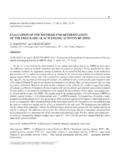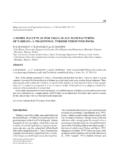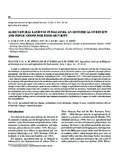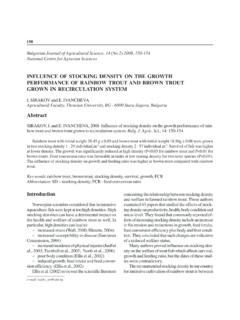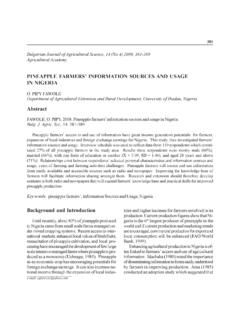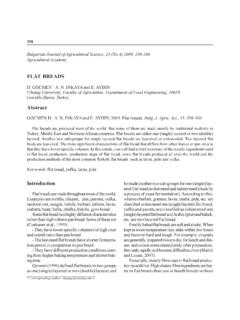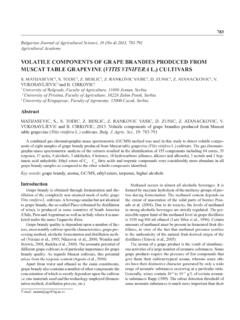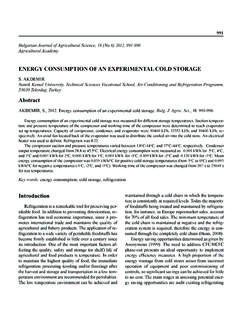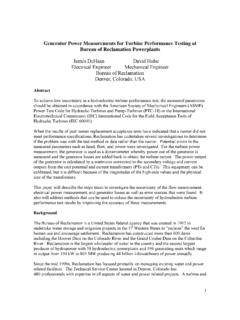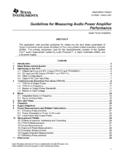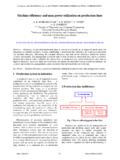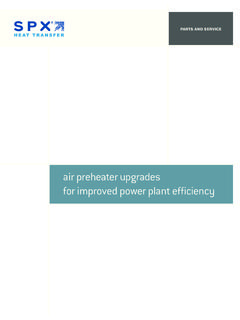Transcription of FIELD PERFORMANCE OF VST SHAKTI POWER …
1 517 Bulgarian Journal of Agricultural Science, 14 (No 5) 2008, 517-522 Agricultural AcademyFIELD PERFORMANCE OF VST SHAKTI POWER TILLERON SAWAH RICE PLOTS IN NIGERIA AND GHANAS. Y. ADEMILUYI1 and O. I. OLADELE21 National Center for Agricultural Mecahnisation, Ilorin, Nigeria2 Department of Agricultural Economics, Education and Extension, Botswana College of Agriculture, University of Botswana, GaboroneAbstractADEMILUYI, S. Y. and O. I. OLADELE, 2008. FIELD PERFORMANCE of VST SHAKTI POWER tiller on sawahrice plots in Nigeria and Ghana. Bulg. J. Agric. Sci., 14: 517-522 The paper reports the FIELD PERFORMANCE of VST SHAKTI POWER tiller on sawah rice plots in Nigeria andGhana.
2 This is based on the fact that POWER tillers were re- introduced in Nigerian agriculture in 2001 by Water-shed Initiatives Nigeria by importing few units for sawah rice production technology. The FIELD performanceevaluation of the model was carried out in different rice fields located at Shaba-Maliki and Ejeti village near Bidaon a clayey loamy, sandy soil, under the guinea savannah ecology of Nigeria. The process was repeated in BiemoNo1 and Adugyma in Ghana. These study sites are located about 40 kilometers northwest of Kumasi on theKumasi - Sunyani main road in Ahafo Ano South District which is at the north-western part of the AshantiRegion.
3 The result shows that 93% and 92% were recorded for FIELD efficiency at Ejeti and Shaba-Maliki respec-tively. The difference in effective FIELD capacity obtained at Shaba- Maliki ( ha/hr) and Ejeti ( ha/hr)was due to the variation in the average time of operation, the operational time at Ejeti ( hr/ha) almost doublesthat of Shaba-Maliki ( hr/ha). In Ghana the FIELD efficiency of VST SHAKTI 130D1 POWER tillers Biemso 1and Adugyma were and 82%. On the other hand, the effective FIELD capacity are ha/hr and ha/hr for Biemo1 and Adugyma; while the average time of operation are hr/ha and hr/ha respectively for thelocations in Ghana.
4 The results of One way analysis of variance for FIELD PERFORMANCE of POWER tillers in 4locations show that average time of operations only Ejeti is significantly different from the 3 other locations, whileAdugyma and AhabaMaliki, the effective FIELD capacity differs significantly from Biemso and Ejeti. In terms offield efficiency, Biemso 1 is significantly different from Adugyma but not any difference between Ejeti andShaba-Maliki. The means for slippage is highest in Ejeti and Shaba-Maliki though not significantly differentbetween them but shows high significance difference between the locations in Ghana that is Biuemso 1 words: FIELD PERFORMANCE , VST SHAKTI POWER tiller, sawah rice, FIELD efficiency, slippage, FIELD tillers were re- introduced in Nigerian agri-culture in 2001 by Watershed Initiatives Nigeria byimporting few units for sawah rice production tech-nology.
5 Fashola et al. (2006) noted that the Sawahsystem offers the best option for overcoming the abovestated constraints because of utilized the inland val-leys which are reported to be high in fertility and sus-tained and enhances the water management for riceproduction through pudding and the inlet and outletcanals for irrigation and drainage. Despite the pre-dominance of rainfed agriculture in Nigeria, the Sawahsystem use of inland valleys will enhance continuouscropping and less distribution of the production ac-tivities. Sawah is a multi-functional constructed wet-land, which is a prerequisite for realizing the greenrevolutions as well as for pressing and even restoringecological and Masunaga (2005) reported that thepotential of Sawah based rice farming is enormous inWest Africa in order to stimulate the long awaited greenrevolution.
6 This is predicated on the fact that the agro-ecological conditions of the core region of West Af-rica are quite similar to those of northeastern Thai-land, where is a one of the rice center in the to twenty million ha of sawah can produce addi-tional food for more than 300 million people in sawah based rice farming can overcome such soilfertility problems through the enhancement of the geo-logical fertilization process, conserving water re-sources, and the high PERFORMANCE multi-functionalityof the sawah type wetlands. The term sawah refers toleveled and bunded rice fields with inlet and outletconnecting irrigation and role of farm POWER in the development of ag-ricultural is well established.
7 The total area under cul-tivation and the timeliness and efficiency of accom-plishing crop husbandry tasks is strongly influencedby the amount of available far POWER and its efficientuse. The increased usage of farm POWER for cultiva-tion creates further demand for related agriculturalmachinery for harvesting and storage and generatesemployment opportunities in the agricultural serviceindustry (Kong et al., 1983). It is therefore importantto seek information concerning available farm powerand its application in various agricultural activities ( preparation, sowing, weeding, spraying, harvest-ing, processing, etc.)
8 This information is also of greatimportance for planning exercises as it influences thedesign and implementation of future policies. A largenumber of POWER tillers (Akitu, Yanmar, Mitsubishi,Satoh, Kubota, Hako and Agria) were imported fromJapan for study at various research centers during 1955to 1960 in terms of their suitability to local the basis of the observations of the testing, planswere made to manufacture the POWER tiller in the coun-try and to popularize the same among POWER tiller is a multipurpose hand tractordesigned primarily for rotary tilling and other opera-tions on small farms.
9 While in operations, an opera-tor walks behind to maneuver it. It is also known as agarden tractor, hand tractor, walking tractor or a two-wheel tractor. Non-availability of matching equipmentfor different farm operations limits the versatility ofthe POWER tillers. Implements initially offered with thepower tillers included rotavator attachment, trailer andin some cases a plough and ridger. The initial intro-duction of POWER tillers was without a complete rangeof matching equipment (Kathirvel et , 2000).There are many factors affecting the use and de-velopment of tractors, such as agricultural conditions,farming requirements, management scale, economicconditions, technical level of manufacture, and farmer sexperience.
10 In consideration of Nigeria s agriculturalconditions, small tractors are more adaptable. Smalltractors are suitable to agricultural conditions and farm-ing requirements in most areas. Among the arablelands in Nigeria, the hilly area represents a great pro-portion. In North Central management scale limitsare FIELD size while in paddy fields, land leveling limitsthe FIELD size, using large and medium tractors on small-farm sizes is uneconomical. As the small tractors havethe advantage in size, light-weight and good maneu-verability. Small tractors are suitable to the level ofmechanical knowledge and management in rural ar-eas.
